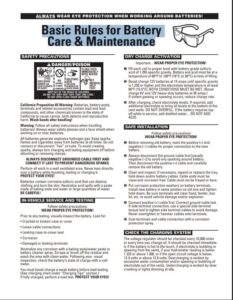Basic Rules for Battery Care & Maintenance

Download: https://www.dekabatteries.com/assets/base/0004.pdf
The document is a battery safety and maintenance guide from Deka Batteries. Here’s a summary of its key points:
1. Safety Precautions
-
Batteries contain lead and sulfuric acid, which can cause serious health issues.
-
Always wear eye protection and work in well-ventilated areas.
-
Hydrogen gas from batteries is explosive—avoid sparks, flames, and smoking.
-
Disconnect the grounded cable first and reconnect it last to prevent sparks.
2. Battery Inspection & Maintenance
-
Before testing, check for cracks, leaks, loose connections, and corrosion.
-
Clean corrosion with a baking soda and water paste.
-
Use a voltmeter to check the state of charge.
-
Charge weak batteries before performing load tests.
3. Charging Guidelines
-
Never charge a frozen battery; allow it to warm first.
-
Overcharging shortens battery life—follow manufacturer instructions.
-
Gel and AGM batteries require special chargers.
-
Charge at 1/3 of the reserve capacity rating and avoid exceeding 16 volts.
4. Battery Installation
-
Mark and disconnect cables properly before removal.
-
Clean terminals before installing a new battery.
-
Tighten connections properly—do not over-tighten.
-
Coat terminals with corrosion protection spray.
5. Testing Methods
-
Load Testing: Determines battery performance under load.
-
Conductance Testing: Predicts battery health based on electrical response.
-
Hydrometer/Voltage Testing: Checks charge state and battery condition.
6. Jump-Starting Procedures
-
Follow the correct order when connecting jumper cables:
-
Positive (+) to Positive (+)
-
Negative (−) to engine block (away from the battery)
-
-
Avoid connecting to moving parts or fuel lines.
7. Battery Storage & Stock Rotation
-
Store batteries in a cool, dry place, upright.
-
Follow First In, First Out (FIFO) rotation to use older stock first.
-
Test and recharge stored batteries every 4-6 months.
8. Selling & Selecting the Right Battery
-
Sell based on cranking amps, not just warranty period.
-
Consider temperature effects—cold climates require higher cranking power.
-
Vehicles with high electrical loads need a stronger battery.
This guide emphasizes safety, proper handling, testing, and maintenance to extend battery life and prevent hazards. Let me know if you need a more detailed breakdown!